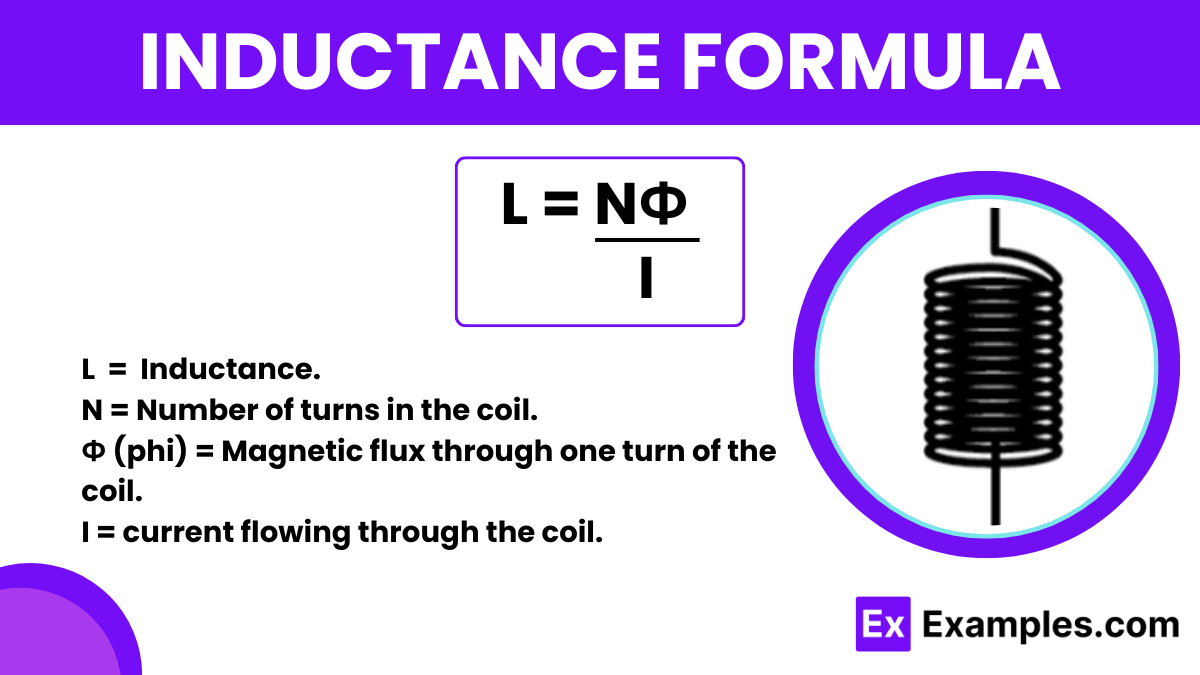What is the SI unit of inductance?
Farad
Henry
Tesla
Ohm


the formula for inductance in an electrical coil is essential for comprehending how electromagnetic circuits operate. This formula is represented as:
To derive this formula, start by considering Faraday’s Law of Electromagnetic Induction, which states that the induced EMF in a coil is proportional to the rate of change of magnetic flux through the coil. If the flux changes as a result of a change in current, the proportionality constant between the induced EMF (ε) and the rate of change of current is the inductance 𝐿. Thus, we express this relationship as:
Here, the negative sign indicates that the induced EMF acts to oppose the change in current, according to Lenz’s Law. If you integrate this expression under the assumption of constant inductance, you can correlate the total flux (NΦ) to the current and number of turns, leading to the formula stated.
The concept of inductance was discovered by Joseph Henry in the 1830s, around the same time Michael Faraday was working on electromagnetic induction. Henry’s work was instrumental in advancing the understanding of electromagnetic fields and their practical applications, like in the design of electric motors and generators.
Problem Statement: A solenoid has 200 turns and a magnetic flux of 2×10⁻³ webers per turn when a current of 5 amperes flows through it. Calculate the inductance of the solenoid.
Solution: Use the formula
𝐿 = 𝑁Φ / 𝐼.
Substitute the given values: 𝐿=200×2×10⁻³ / 5=0.08 H
The inductance of the solenoid is 0.08 Henry.
Problem Statement: If the current in the above solenoid changes to 10 amperes, what is the new inductance, assuming magnetic flux per turn remains the same?
Solution: Substitute the new current into the formula:
𝐿=200×2×10⁻³ / 10=0.04 H The new inductance is 0.04 Henry.
Problem Statement: You need to achieve an inductance of 0.5 Henrys in a solenoid with a magnetic flux of 5×10⁻³ webers per turn and a current of 2 amperes. How many turns must the solenoid have?
Solution: Rearrange the formula to solve for N:
𝑁=𝐿×𝐼 / Φ
𝑁=0.5×2 / 5×10⁻³ =200 turns
The solenoid must have 200 turns.
Inductance measures an electrical component’s ability to store energy magnetically; its SI unit is the Henry (H).
Inductance is an electrical property that quantifies a circuit’s capacity to induce voltage from a change in current. An inductor is a device that utilizes this property.
Inductance affects both AC and DC circuits, but its properties become particularly significant in altering current flow in AC circuits due to frequency-dependent behavior.
Text prompt
Add Tone
10 Examples of Public speaking
20 Examples of Gas lighting
What is the SI unit of inductance?
Farad
Henry
Tesla
Ohm
What is the formula for inductance (L) in terms of the induced electromotive force (emf) and the rate of change of current (di/dt)?
L = emf/I
L = emf × dt/di
L = emf/di/dt
L = di/dt/emf
If the inductance is 2 H and the rate of change of current is 3 A/s, what is the induced emf?
2 V
3 V
6 V
1.5 V
What happens to the inductance if the number of turns in a coil is doubled, assuming all other factors remain constant?
It remains the same
It is halved
It is doubled
It is quadrupled
Which of the following factors does NOT affect the inductance of a coil?
Number of turns
Cross-sectional area of the coil
Length of the coil
Frequency of the applied current
If the induced emf is 12 V and the rate of change of current is 3 A/s, what is the inductance?
2 H
3 H
4 H
5 H
Which of the following increases the inductance of a coil?
Decreasing the number of turns
Increasing the length of the coil
Increasing the cross-sectional area
Decreasing the permeability of the core
What is the relationship between inductance (L) and the number of turns (N) in a coil?
L ∝ N
L ∝ N²
L ∝ 1/N
L ∝ 1/N²
Which parameter is directly proportional to the inductance of a coil?
Length of the coil
Number of turns squared
Core material density
Frequency of the current
Which of the following is NOT a factor in determining the inductance of a coil?
Number of turns
Cross-sectional area
Core length
Color of the wire
Before you leave, take our quick quiz to enhance your learning!

